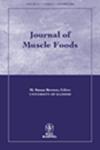DETECTION OF THE INDIGENOUS SALMONELLA LEVEL IN A RADIATION-STERILIZED PURE CULTURE AND MEAT MODEL SYSTEM
Abstract
ABSTRACT
The quantitative detection of the radiation-sterilized Salmonella typhimurium in a pure culture and ground beef, pork and chicken meat model system was evaluated using a visual immunoprecipitate (VIP) assay kit and an enzyme-linked immunosorbent assay (ELISA) method. The VIP kit and ELISA detected 105 cells/mL or above of the enriched culture of S. typhimurium, and the detection limit of the irradiated Salmonella was comparable to that of the intact cells. There was no significant difference between the detection limit of the enriched culture and that of inoculated and irradiated S. typhimurium in model system of ground beef, pork and chicken. Irradiation did not give any effect on the immunochemical detection of S. typhimurium within a dose of 5 kGy; therefore, an immunodetection method may be a simple way for the quantitative analysis of the indigenous microbes in a radiation-sterilized food.
PRACTICAL APPLICATIONS
One of the consumers' concerns about food irradiation technology is the abuse of the technology to sterilize food products without meeting the hygienic standard such as good manufacturing practice before irradiation of food. A simple method to detect the indigenous microorganism level before irradiation process is tested as a quality assurance measure using a pure culture of Salmonella typhimurium and inoculated meat model system. This simple test will be helpful by providing a trust for both consumer and manufacturer to verify that their products are produced under hygienic standard before irradiation treatment.

 求助内容:
求助内容: 应助结果提醒方式:
应助结果提醒方式:


